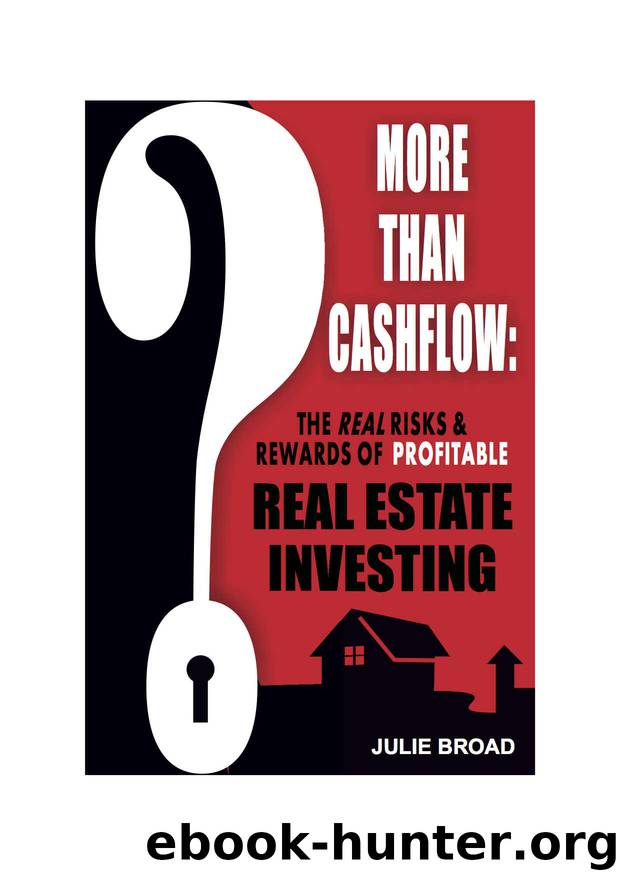More Than Cashflow: The Real Risks & Rewards of Profitable Real Estate Investing by Julie Broad

Author:Julie Broad
Language: eng
Format: mobi
Publisher: Stick Horse Publishing
Published: 2013-07-18T14:00:00+00:00
CHAPTER SEVEN.
Increasing Cash Flow With Rent to Own
Rent to own is when a tenant rents your property with the option to purchase it. They move in with the intention of buying it from you in the future. You set their purchase price at the beginning; they pay a fee for the option to purchase it in the future; and a portion of their rent is a credit that builds up over time towards their purchase.
It generates more cash flow because the tenants are paying a higher than market rent for their property and they are responsible for basic maintenance. You also typically don’t need property management because of the quality of tenants that move in and because they are responsible for taking care of repairs up to a certain dollar amount ($300 in our case, but many other investors have their tenants handle up to $500).
The added benefit I’ve realized over time is that we’re helping people in a really big way. Our rent to own tenants give us big warm hugs, invite us for dinner, make us handmade thank you cards – and they invest in fixing up their homes. One of our tenants painted the interior and exterior, built a garage and fenced the back yard of his home. Our regular tenants, on the other hand, rarely mow the lawn!
Typical rent to own tenants are folks who are new to Canada and haven’t established credit; or they are going through a divorce and their assets are tied up; or they’ve beaten up their credit because of a health reason; or they haven’t saved enough for a full down payment to qualify for financing; or just one setback has kicked their credit down to a point where the banks aren’t interested. In all of these scenarios, they need a helping hand because the banks won’t help them and the other options available don’t make financial sense for them.
Most investors agree that it’s a great addition to your portfolio to create more cash flow; but where the debate arises around rent to own is: What comes first – the tenant or the property?
No matter which approach you take, screening your tenants is critical. Beyond the usual tenant screening of reference checks, employment verification and credit score review, you must make sure the tenants have income levels that will allow them to qualify for financing in the future. You need to review their debt load to make sure a bank is likely to work with them in the future; and you need to review their plan to correct whatever issue they have – to make sure they know what steps they have to take to qualify for future financing. Honesty from a prospective rent to own tenant is imperative.
Where rent to own can get a bad reputation is when it’s abused by investors who skip the above step. Some are lazy, some don’t understand how it works, but some actually do it intentionally. They put a tenant in a home knowing the tenant will never be able to buy from them.
Download
This site does not store any files on its server. We only index and link to content provided by other sites. Please contact the content providers to delete copyright contents if any and email us, we'll remove relevant links or contents immediately.
Investing For Dummies by Eric Tyson(2468)
The Book on Rental Property Investing by Turner Brandon(1400)
The Book On Tax Strategies for the Savvy Real Estate Investor by Amanda Han & Matthew MacFarland(1335)
Every Landlord's Legal Guide by Janet Portman & Stewart Marcia & Ralph Warner(1318)
The Thibaults by Roger Martin Du Gard(1303)
Personal Finance For Dummies (9th Edition) by Eric Tyson(1270)
Real Estate Licensing Exams by Raymond D. Modglin(1146)
Investing 101 by Michele Cagan(1088)
Bill Bryson by At Home(1066)
The Real Book of Real Estate by Robert T. Kiyosaki(1031)
The Plaza by Julie Satow(1029)
Irrational Exuberance by Shiller Robert J. J(1024)
7 Steps to Wealth by John L. Fitzgerald(964)
Mortgages 101 by David Reed(959)
Real Estate Math Demystified by Steven P. Mooney(947)
The Business of Flipping Homes by William Bronchick(940)
Now I Sit Me Down by Witold Rybczynski(918)
Retail Development by Anita Kramer(907)
SAP Flexible Real Estate Management by Jayant Daithankar(904)
